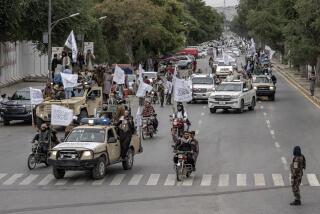Angst in Afghanistan
- Share via
With the departure of the last Soviet combat troops from Afghanistan, the nine-year-long war seems poised to enter a new and perhaps more violent phase. President Najibullah’s Marxistregime and defection-ridden army are coming under intensified siege from the estimated 200,000 armed guerrillas scattered around the Texas-size country--30,000 of whom already surround Kabul, the capital. Virtually everyone believes that the regime must fall. Whether it lasts days, weeks or months could depend on how well the resistance groups coordinate their military activities. But even if tactical cooperation is achieved--and the war has seen precious little of that--it is unlikely that an effective coalition government will soon emerge to supplant what the Red Army left behind.
Afghanistan, the world is about to reminded, remains a country riven by tribal loyalties and ethnic jealousies. Seven major guerrilla groups have emerged from the 3 million Afghan refugees in next-door Pakistan; other forces have come from among the 2 million refugees who fled to neighboring Iran. A council of resistance organizations summoned to form an interim government hasn’t been able to agree on how power should be apportioned. Muslim fundamentalists dream of an Afghanistan reborn as an Iran-style Islamic republic, repressive and reactionary. Many oppose the fundamentalists. They know what they are against; the problem is that they don’t always agree on what they are for.
President Bush says that American military aid to the resistance groups--$2 billion worth has so far been delivered--will go on until the Soviet Union stops supplying Najibullah. A quick rethinking of that policy will be called for, however, if tribal and ideological turbulence produces not a consensus for post-Marxist unity but a renewal of civil strife. Some in Washington are already talking in terms of an Afghanistan faced with chronic conflict, like Ethiopia or Sudan. Some, fearing the worst, even warn about the possible Lebanonization of the country. Already different factions are getting money, arms and advice from Pakistan, Iran, Saudi Arabia and perhaps other Islamic countries. It would be naive to think these are selfless gifts.
This war has taken a terrible toll. Nearly one-third of Afghanistan’s 16 million people have been forced to flee the country, hundreds of thousands have died, tens of thousands have been maimed. But even if peace were somehow miraculously to take hold, Afghans will probably continue to die of war wounds for years to come, victims of the millions of anti-personnel mines indiscriminately left strewn over the landscape by the Soviets. To this grim prospect must be added the chances of high-toll internecine warfare as the competition for power and influence deepens.
The Afghan resistance movement, with help from its friends, has reached a point where its triumph seems assured. The foreign invader has been driven out, a regime with only the barest popular support seems on the edge of being overthrown. Now comes a new challenge, the unsettled and deeply contentious question of how the political nature of Afghanistan’s future will be decided.
More to Read
Sign up for Essential California
The most important California stories and recommendations in your inbox every morning.
You may occasionally receive promotional content from the Los Angeles Times.













